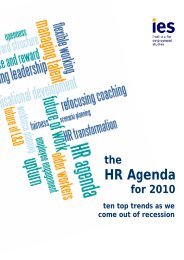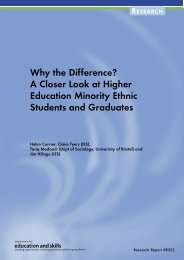Post-16 Transitions: a Longitudinal Study of Young People with ...
Post-16 Transitions: a Longitudinal Study of Young People with ...
Post-16 Transitions: a Longitudinal Study of Young People with ...
Create successful ePaper yourself
Turn your PDF publications into a flip-book with our unique Google optimized e-Paper software.
Figure 4:3: Reasons why Year 11 discussion <strong>with</strong> Careers Service/Connexions was helpful<br />
70<br />
60<br />
50<br />
Percent<br />
40<br />
30<br />
20<br />
10<br />
0<br />
Explained the options<br />
available<br />
Provided information<br />
Helped <strong>with</strong> progress<br />
into work/further<br />
education<br />
Helped <strong>with</strong> making<br />
decisions<br />
Planned other support<br />
Source: IES/MORI 2003<br />
etc. <strong>Young</strong> people in Connexions areas were slightly more<br />
likely to report that they had found this meeting fairly or very<br />
helpful (78 per cent) compared to young people in non-<br />
Connexions areas (70 per cent).<br />
4.3.2 Helpfulness <strong>of</strong> careers support<br />
Most young people reported that this future-focussed meeting<br />
<strong>with</strong> the Careers Service/Connexions had been helpful<br />
because it had explained the options available to them and<br />
had provided information. More than half <strong>of</strong> young people<br />
who could recall having such a discussion, and had found it<br />
helpful, reported this to be the case (see Figure 4.3). Far fewer<br />
young people reported that these discussions had helped them<br />
to progress into work or further education (just over onequarter<br />
<strong>of</strong> all young people who could remember having such<br />
a discussion and who had found it to be helpful). No real<br />
differences were observed for young people in Careers Service<br />
areas or Connexions partnerships areas.<br />
Turning to why the discussions <strong>with</strong> the Careers Service/<br />
Connexions had been unhelpful (24 per cent <strong>of</strong> all young<br />
people recalling such a discussion reported this to be the case),<br />
between one-quarter and one-third <strong>of</strong> young people said this<br />
was because the meeting did not provide the right sort <strong>of</strong><br />
information (32 per cent) or did not provide enough<br />
information (27 per cent; see Table 4.12). Approximately onefifth<br />
<strong>of</strong> young people who found the meeting to be unhelpful<br />
also reported that it did not help them in their decisionmaking<br />
and/or did not explain the full range <strong>of</strong> options<br />
available. A similar proportion <strong>of</strong> these young people found<br />
the meeting to be confusing. Once again, no real differences<br />
<strong>Post</strong>-<strong>16</strong> <strong>Transitions</strong> <strong>of</strong> <strong>Young</strong> <strong>People</strong> <strong>with</strong> SEN: Wave 2 39

















